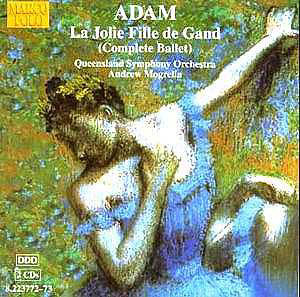This performance is the first of two complete Adam ballets
that Marco Polo has issued. It was written a year after the immediately
successful Giselle and upstaged Thomasís opera Le Guerillero,
performed on the same evening in Paris.
Adolphe Adam wrote: "My only aim is
to write music which is transparent, easy to understand and pleasing
to the public." To be certain, his music carries that effervescence
and warm colouring which complements the ballet so ideally.
Adam was trained at the Paris Conservatoire, initially
as an organ scholar, having been prepared by his pianist and composer
father. Boieldieu communicated a love for the theatre to Adam and pointed
out the lucrative returns that composers such as he could receive by
active involvement. Adam set out on a musical career that resulted in
around forty lyric works, with some twenty vaudevilles, ballets and
opéra comiques. He is best remembered for his opéra comiques:
Le Postillon de Longjumeau and Si jíétais Roi;
along with the ballet, Giselle. Composed in 1841, Giselle
became a lasting success and still appears in today's international
repertoire. Only a year later La Jolie Fille de Gand was written.
The opportunity that Marco Polo have given us to hear two of his less-famous
ballets is most welcome.
La Jolie Fille de Gand is a full-length
ballet lasting 2hrs 12mins (despite it being premièred alongside
an opera). The work is based on a book by Jules-Henri Vernoy, Marquis
de St. Georges and Perrot with a story set in Ghent, Belgium concerning
a forthcoming marriage between Beatrix and Benedict. After an overture
the curtain rises on a goldsmithís shop, where Beatrix the daughter
of its owner is discovered. Although her beloved brings flowers she
is distracted when a stunning Marquis enters the shop. He has come to
Ghent to attend the fair.
A second colourful scene opens on a busy town square
where the fair is in progress. Bowmen, guilds and pageant wagons provide
a spectacle to match Adamís colourful music. The Marquis wins a shooting
match contest over Benedict and dares to give the garland he wins to
Benedictís lover, Beatrix. This reinforces the girlís infatuation for
the Marquis. The festivities are interrupted by a gathering storm.
The Marquis later abducts Beatrix, but not against
her will, and a ball is thrown. But by now, the Marquis has become attracted
to another and provokes Beatrix to jealousy. Benedict has gained access
to the ball and challenges the Marquis by drawing his sword. One of
Benedictís supporters curses Beatrix who faints into the arms of the
Marquis.
A new act, set at night in the garden of the Marquisí
villa, reveals the company feasting. The Marquis is invited to gamble
by an old friend where he loses everything. Beatrix assures him that
they can live on her gold and jewels.
Following a complex entanglement, we return to Ghent
where Benedict is about to marry another. Beatrix returns to be faced
with this and the knowledge that her father is dead. In a final scene
Beatrix awakens, realising that the past events have been a dream. Events
conclude with the true wedding about to take place.
The balletís music, composed during a fertile period
with Adam at the height of his creative talents, is elegant. In orchestration,
the piccolo is prominent and is used to brighten many of the theme lines.
The music is engaging and at times powerful. It goes without saying
that the ballet contains charming melodies, Adam never being short of
good melodic ideas to aid description of a scene.
However, CD1 tk7 opens with a passage imitating church
chimes, but to me its tempo sounds lethargic and inappropriate to the
mood of the scene. Had the opening been played nearly twice as fast
with improved dynamics, the impact would have been considerably heightened
and would have been more likely to complement the bustling activity
on stage. Noticing this caused me to reassess the pace of the rest of
the work. Without sight of score tempi markings one cannot be sure of
what Adam intended, but I can believe that Mogreliaís sometimes ponderous
pace (despite its stately effect), does not accurately accompany a fitting
choreography. When compared with Mogreliaís other Adam ballet recording
for Marco Polo, Le Filleulle des Fées (recorded around
the same time by the same orchestra) this reading sometimes misses an
opportunity to sparkle with energetic vitality. Both the orchestra and
recording sound well.
The booklet by Keith Anderson give good background
material on Adam and a full and detailed synopsis taking the listener
through the ballet's development track by track. The notes are written
in English, French and German. Although this Marco Polo has been issued
for some time, it complements Adamís recently released other ballet,
Le Filleulle des Fées on 8.223734-35, reviewed on a separate
web page.
Raymond Walker


